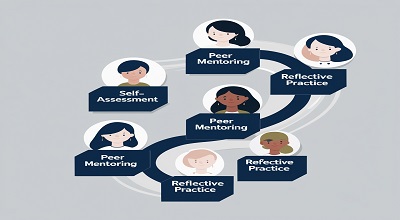Teacher Learning Pathways
Teacher Learning Pathways: Teachers play a crucial role in shaping the future by educating students. However, to remain effective, they must continuously upgrade their skills through structured teacher learning pathways. These pathways help educators stay updated with the latest teaching methodologies, technological advancements, and pedagogical strategies.
In this comprehensive guide, we will explore the latest teacher learning pathways, their importance, types, real-world examples, and emerging trends.
What Are Teacher Learning Pathways?
Teacher learning pathways refer to structured routes that educators follow to acquire new skills, knowledge, and certifications. These pathways can be formal (degree programs) or informal (self-paced online courses).
Key Components:
- Goal-Oriented Learning – Focused on improving teaching effectiveness.
- Flexible Options – Includes online, hybrid, and in-person training.
- Continuous Improvement – Encourages lifelong learning.
Why Are Teacher Learning Pathways Important?
- Enhances Teaching Quality – Keeps educators updated with modern techniques.
- Boosts Student Engagement – Teachers learn new ways to make lessons interactive.
- Career Advancement – Opens doors to promotions and leadership roles.
- Adaptation to Technology – Helps integrate EdTech tools like AI and VR in classrooms.
Types of Teacher Learning Pathways
Formal Education
- Example: Pursuing a Master’s in Education (M.Ed) or a Ph.D. in Pedagogy.
- Benefits: Deepens subject expertise and research skills.
Professional Development Workshops
- Example: Attending workshops by Google for Education or ISTE.
- Benefits: Hands-on training in new teaching tools.
Online Courses and Certifications
- Example: Coursera’s “Foundations of Teaching for Learning” or edX’s “Teaching with Technology”.
- Benefits: Flexible, self-paced learning.
Peer Learning and Collaboration
- Example: Joining Professional Learning Communities (PLCs).
- Benefits: Sharing best practices with fellow educators.
Self-Directed Learning
- Example: Reading research papers, watching TED Talks, or following education blogs.
- Benefits: Personalized learning at one’s own pace.
Latest Trends in Teacher Learning Pathway
- Micro-Credentials – Short, skill-specific certifications.
- Gamified Learning – Using badges and leaderboards in PD programs.
- AI-Powered Coaching – Tools like TeachFX provide real-time feedback.
- Hybrid PD Models – Combining online and in-person training.
Examples of Effective Teacher Learning Pathways
1: National Board Certification (NBC)
- Pathway: Rigorous certification process focusing on advanced teaching standards.
- Outcome: Recognized as a mark of teaching excellence.
2: Apple Teacher Program
- Pathway: Free online training on using Apple tools in education.
- Outcome: Teachers earn badges and improve tech integration skills.
3: Harvard’s “Teaching for Understanding” Course
- Pathway: Online course on deep learning strategies.
- Outcome: Enhances critical thinking in lesson planning.
More Here: Autonomous Security Agents
How to Choose the Right Learning Pathway?
- Assess Your Needs – Identify skill gaps.
- Check Accreditation – Ensure the program is recognized.
- Consider Flexibility – Opt for part-time or online if needed.
- Look for Peer Reviews – Check feedback from other teachers.
Challenges in Teacher Learning Pathway
- Time Constraints – Balancing PD with teaching duties.
- Cost Barriers – Some certifications are expensive.
- Lack of Support – Schools may not provide funding or incentives.
Future of Teacher Learning Pathway
- Personalized PD – AI-driven recommendations for courses.
- Virtual Reality Training – Simulated classroom experiences.
- Global Collaboration – Teachers learning from peers worldwide.
Conclusion
Teacher learning pathways are essential for professional growth and student success. By exploring formal education, online courses, peer collaboration, and self-learning, educators can stay ahead in their careers.
For more resources, visit TeacherEducator.com.
FAQs
Q1. What is the best teacher learning pathway for beginners?
A: Start with free online courses like Google’s Teacher Center or Coursera’s introductory programs.
Q2. Are micro-credentials worth it?
A: Yes, they provide specialized skills and are often recognized by schools.
Q3. How can schools support teacher PD?
A: By offering funding, time for training, and access to workshops.
Free Here: Download YouTube Pro APK
